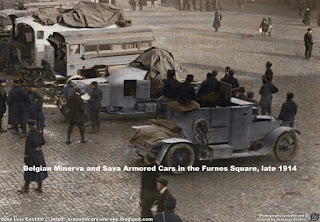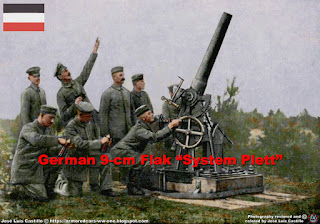Royal Naval Air Service (RNAS) Lanchester Armoured Car.
First vehicle [Command] of the 3rd Section [C] of the 5th Squadron belonging to the Royal Naval Armoured Car Division (RNACD).
United Kingdom, before leaving for France in April 1915.
**************
Lanchester Armored Car No. 1 [Command Vehicle] of Section C [3rd Section] of the 5th Squadron belonging to the Royal Naval Armored Car Division (RNACD)
The photograph was taken at Wormwood Scrubs, Kensington, North West London, headquarters of the RNACD. To the left of the photograph, partial view of one of the two large gas tanks of Gas Light & Coke Co., on the right, buildings of the Talbot workshops.
5 Squadron (TO&E)
A Section (1st Section)
Lanchester Armored Car No.1 (5-A-1)
Lanchester Armored Car No.2 (5-A-2)
Lanchester Armored Car No.3 (5-A-3)
Lanchester Armored Car No.4 (5-A-4)
Seabrook Armored Car No.5 (5-A-5)
B Section (2nd Section)
Lanchester Armored Car No.1 (5-B-1)
Lanchester Armored Car No.2 (5-B-2)
Lanchester Armored Car No.3 (5-B-3)
Lanchester Armored Car No.4 (5-B-4)
Seabrook Armored Car No.5 (5-B-5)
C Section (3rd Section)
Lanchester Armored Car No.1 (5-C-1)
Lanchester Armored Car No.2 (5-C-2)
Lanchester Armored Car No.3 (5-C-3)
Lanchester Armored Car No.4 (5-C-4)
Seabrook Armored Car No.5 (5-C-5)
All the squads gave their armored cars their name.
The names given to the armored cars of the 5th Squadron, all started with the letter F.
All 15 armored cars, 12 Lanchester and 3 Seabrook, were delivered to the unit at the end of March 1915.
The following month the Squadron was sent to France.
Later, in May 1915, the 3 Seabrook of the 5th Squadron and the 3 Seabrook of the 2nd Squadron were removed from both units to form a new armored formation, homogeneous with respect to the speed, manoeuvrability and armament of their vehicles: the 16th Squadron.
The new numbering (theoretical) of the Seabrooks of this formation was:
A-1
A-2
A-3
A-4
A-5
A-6
The 16th Squadron operated in France with the 12 Rolls-Royce of the 2nd Squadron commanded by the Duke of Westminster.
**************
Coche Blindado Lanchester Nº 1 [Vehículo de Mando] de la Sección C [3ª Sección] del 5º Escuadrón perteneciente a la División de Coches Blindados de la Marina Real [Royal Naval Armoured Car Division (RNACD)].
La fotografía fue tomada en Wormwood Scrubs, Kensington, North West London, sede de la RNACD. A la izquierda de la fotografía, vista parcial de uno de los dos grandes depósitos de gasolina de la empresa Gas Light & Coke Co., a la derecha, edificios de los talleres Talbot.
5º Escuadrón (TO&E)
Sección A (1ª Sección)
Coche Blindado Lanchester Nº 1 (5-A-1)
Coche Blindado Lanchester Nº 2 (5-A-2)
Coche Blindado Lanchester Nº 3 (5-A-3)
Coche Blindado Lanchester Nº 4 (5-A-4)
Coche Blindado Seabrook Nº 5 (5-A-5)
Sección B (2ª Sección)
Coche Blindado Lanchester Nº 1 (5-B-1)
Coche Blindado Lanchester Nº 2 (5-B-2)
Coche Blindado Lanchester Nº 3 (5-B-3)
Coche Blindado Lanchester Nº 4 (5-B-4)
Coche Blindado Seabrook Nº 5 (5-B-5)
Sección C (3ª Sección)
Coche Blindado Lanchester Nº 1 (5-C-1)
Coche Blindado Lanchester Nº 2 (5-C-2)
Coche Blindado Lanchester Nº 3 (5-C-3)
Coche Blindado Lanchester Nº 4 (5-C-4)
Coche Blindado Seabrook Nº 5 (5-C-5)
Todos los escuadrones dieron nombre [bautizaron] a sus coches blindados.
Los nombres dados a los coches blindados del 5º Escuadrón, comenzaban todos por la letra F.
La totalidad de los 15 coches blindados, 12 Lanchester y 3 Seabrook, fueron entregados a la unidad a finales de marzo de 1915.
Al mes siguiente el Escuadrón fue enviado a Francia.
Posteriormente, en Mayo de 1915, los 3 Seabrook del 5º Escuadrón y los 3 Seabrook del 2º Escuadrón, fueron retirados de ambas unidades para formar una nueva formación blindada, homogénea respecto a la velocidad, maniobrabilidad y armamento de sus vehículos: el 16º Escuadrón.
La nueva numeración (teórica) de los Seabrooks de esta formación fue:
A-1
A-2
A-3
A-4
A-5
A-6
El 16º Escuadrón operó en Francia junto a los 12 Rolls-Royce del 2º Escuadrón al mando del Duque de Westmister.




















